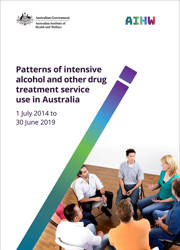Patterns of intensive alcohol and other drug treatment service use in Australia, 1 July 2014 to 30 June 2019
Citation
AIHW
Australian Institute of Health and Welfare (2021) Patterns of intensive alcohol and other drug treatment service use in Australia, 1 July 2014 to 30 June 2019, AIHW, Australian Government, accessed 27 April 2024. doi:10.25816/vn3b-ex32
APA
Australian Institute of Health and Welfare. (2021). Patterns of intensive alcohol and other drug treatment service use in Australia, 1 July 2014 to 30 June 2019. Canberra: AIHW. doi:10.25816/vn3b-ex32
MLA
Australian Institute of Health and Welfare. Patterns of intensive alcohol and other drug treatment service use in Australia, 1 July 2014 to 30 June 2019. AIHW, 2021. doi:10.25816/vn3b-ex32
Vancouver
Australian Institute of Health and Welfare. Patterns of intensive alcohol and other drug treatment service use in Australia, 1 July 2014 to 30 June 2019. Canberra: AIHW; 2021. doi:10.25816/vn3b-ex32
Harvard
Australian Institute of Health and Welfare 2021, Patterns of intensive alcohol and other drug treatment service use in Australia, 1 July 2014 to 30 June 2019, AIHW, Canberra. doi:10.25816/vn3b-ex32
PDF | 2.4Mb
Clients accessing alcohol and other drug treatment services often receive multiple episodes of treatment, with some clients requiring more intensive treatment to achieve their goals. This report describes 3 distinct client cohorts based on their patterns of treatment service use between 1 July 2014 and 30 June 2019. Clients who received intensive treatment were more likely than other cohorts to report receiving treatment for multiple principal drugs of concern and for more main treatment types across episodes.
- ISBN: 978-1-76054-825-4
- DOI: 10.25816/vn3b-ex32
- Cat. no: HSE 251
- Pages: 40
-
Clients receiving intensive treatment accounted for 3.2% of all clients, but 16% of all closed treatment episodes
-
There was no dominant pattern of treatment service use among clients who received intensive AOD treatment
-
61% of clients who received intensive treatment reported multiple principal drugs of concern across episodes
-
7 in 10 (70%) clients who received intensive treatment received at least 3 different treatment types



